Operator Dies After Being Run Over by His Bulldozer in West Virginia.
Case: 00WV012-01
Release Date: February 14, 2001
SUMMARY
On April 13, 2000, a 70-year-old male landfill heavy equipment operator (victim) died of injuries sustained when the bulldozer he was operating backed over him. The victim was using a 19 year old bulldozer to spread soil which was being supplied by a dump truck. The soil spreading operation was part of the landfill’s routine internal road building efforts. Prior to the fatal incident, he had left the bulldozer unattended on level ground. The unattended bulldozer was running at full throttle and both the transmission neutral safety lock and the parking brake had not been engaged. The dozer’s blade was also left partially elevated. As the dump truck driver approached with another load, he noticed the unattended bulldozer. The truck driver then made his usual U-turn before backing up to position himself for dumping. Although there were no witnesses, it is believed that during this period, the victim began to climb up on the bulldozer on the same side as the transmission selector lever. Due to a trip, stumble, loss of balance or inadvertent hand placement, it is believed he bumped the transmission into 2nd speed reverse. It is also believed that he was either standing on the bulldozer’s left track or was thrown onto the track by the sudden jerk of the transmission engagement. He then rode the track backwards until falling off. The bulldozer’s left track ran over the victim’s chest cavity. As the truck driver began backing up, he searched his mirrors for the unattended dozer and could not locate it. Opening his door and turning his body for better visibility, he spotted the victim who had been run over approximately 78 feet from the bulldozer’s original position. He then saw the bulldozer, which had continued another 25 feet and was beginning to bury itself after having gone over an embankment. Realizing the severity of the injury, the truck driver immediately drove to another part of the site for help. After EMS was contacted, the site’s supervisor returned, checked the victim, and then shut down the unattended bulldozer. EMS arrived within minutes. The victim was pronounced dead at the scene.
The WV FACE investigator concluded that to reduce the likelihood of similar occurrences, employers should:
- ensure that machines are not left unattended unless all precautions necessary to prevent motion have been taken.
- develop, implement, and enforce a written safety program which includes, but is not limited to, task and equipment specific safety procedures, work rules, and worker training in hazard identification, avoidance, and control.
- designate a competent person to conduct frequent and regular site safety inspections.
INTRODUCTION
On April 14, 2000, the WV FACE Program was notified by a newspaper clipping service of a heavy equipment work-related fatality which had occurred the previous day at a fly ash landfill. The WV FACE field investigator contacted the responding law enforcement agency. The case was discussed with the investigating officer and a copy of the police report was obtained. The WV FACE field investigator traveled to the site on May 17, 2000 and met with a representative of the power plant that owns the landfill. This meeting consisted of a discussion of the incident. Additionally, the employee safety booklet and written safety program developed by the victim’s employer was also reviewed. The representative then accompanied the investigator to the incident site to observe and interact with the company who employed the victim. The victim’s employer is under contract to maintain the landfill for the power plant. The piece of equipment was examined and observed while operating. Observation included of a series of tests engaging 2nd speed reverse while at full throttle as it was found after the incident. The transmission control safety lock was also examined to ensure proper function. The truck driver who discovered the victim and who now operates the piece of equipment was interviewed. Photographs were also taken at the site. The death certificate and medical examiner’s report were obtained, as well as OSHA’s investigative report and the equipment manufacturer’s operation manual. In addition, a number of bulldozer operators within the state were also interviewed concerning bulldozer safety.
The employer in this incident was an ash management company. Four employees were present at the time of the incident. There was a formal designated safety director and formal written safety program. Safety training sessions were held periodically. Prior to the incident, there was no documented training concerning heavy equipment.
The victim was an experienced heavy equipment operator. It was reported he had nearly 40 years of experience as a bulldozer operator. He was also a member of the International Union of Operating Engineers.
The victim’s task at the time of the incident was to spread fill dirt which was being supplied by a dump truck throughout the shift. The crew was in the process of constructing another road within the landfill.
INVESTIGATION
On April 13, 2000, a 70-year-old male landfill heavy equipment operator (victim) died of injuries sustained when the bulldozer he was operating backed over him in reverse. The victim was using a 19 year-old bulldozer which was found to be free from defects which could have contributed to this incident. The piece of equipment was being used to spread soil which was being supplied by a dump truck. The soil spreading operation was part of the landfill’s routine internal road building efforts. Prior to the fatal incident, he had left the bulldozer unattended on level ground (see figure 1). The unattended bulldozer was running at full throttle and both the transmission neutral safety lock and the parking brake had not been engaged (see figure 2).
The dozer’s blade was also left partially elevated. As the dump truck driver approached with another load, he noticed the unattended bulldozer. The truck driver then made his usual U-turn before backing up to position himself for dumping. Although there were no witnesses, it is believed that during this period, the victim began to access the bulldozer on the same side as the transmission selector lever (see figure 3). Due to a trip, stumble, loss of balance or inadvertent hand placement, it is believed he bumped the transmission into 2nd speed reverse (see figure 4). It is also believed that he was either standing on the bulldozer’s left track or was thrown onto the track by the sudden jerk of the engagement. He then rode the track back until falling off. The bulldozer’s left track ran over the victim’s chest cavity. As the truck driver began backing up, he searched his mirrors for the unattended dozer and could not locate it. Opening his door and turning his body for better visibility, he spotted the victim, who had been run over approximately 78 feet from the bulldozer’s original position. He then saw the bulldozer, which had continued another 25 feet and was beginning to bury itself after having gone over an embankment (see figure 5). Realizing the severity of the injury, the truck driver immediately drove to another part of the site for help. After EMS was contacted, the site’s supervisor returned, checked the victim, and then shut down the unattended bulldozer. EMS arrived within minutes. He was pronounced dead at the scene.
CAUSE OF DEATH
The cause of death listed on the death certificate was multiple injuries.
RECOMMENDATIONS/DISCUSSION
Recommendation #1: Employers should ensure that machines are not left unattended unless all precautions necessary to prevent motion have been taken.
Discussion: Preventing death and serious injury to heavy equipment operators and their coworkers when equipment is left unattended requires the use of a series of precautionary measures. The very nature of bulldozer operation requires frequent forward/reverse directional change. The transmission’s selector lever is therefore designed for smooth and short throw operation. With the operator’s left arm positioned on the arm rest, the transmission selector lever is within the operator’s palm in an almost “joy-stick” configuration. Therefore with the engine running, solely relying on the transmission’s selector being placed in neutral for non movement is hazardous. Bulldozer manufacturers realize this and therefore incorporate an additional safety device known as a Transmission Control Safety Lock This lever locks the transmission selector in the neutral position. Other precautions include setting the parking brake and lowering/grounding the dozer’s blade. According to the manufacturer of this bulldozer, parking the bulldozer requires the following steps:
- Stop on level ground, and reduce engine speed.
- Move transmission control lever to neutral.
- Engage transmission control safety lock.
- Apply brake pedals and engage brake lock.
- Lower all equipment.
Additionally, CFR 1926.600 (a)(3)(ii) requires that whenever equipment is parked, the parking brake shall be set.1 It was reported that the victim had a history of letting the machine continue to run at a high engine speed when at rest. It was also reported that the victim rarely if ever engaged the transmission control safety lock and set the brakes. The configuration of the above controls as found after the incident appear to reinforce the reported history of not following the necessary safety precautions when dismounting from the bulldozer. If the victim had implemented the proper safety procedures when parking and dismounting, this fatality may have been prevented.
Recommendation #2: Employers should develop, implement, and enforce a written safety program which includes, but is not limited to, task and equipment specific safety procedures, work rules, and worker training in hazard identification, avoidance, and control.
Discussion: The evaluation of tasks to be performed at the work site forms the basis for the development, implementation, and enforcement of a safety program as well as task-specific safety procedures. A key element of any safety program is the communication of task- specific safe work practices and the work rules associated with that task. The employer had a written safety program and employee safety handbook. The handbook addressed the issue of never bypassing a safety device as well as the use of seat belts on heavy equipment. The handbook’s contents did not address the issue of unattended equipment and the specific precautionary steps necessary when leaving the operator’s station. In this incident, the victim was fatally injured when he created and then approached an unsafe situation (an unattended bulldozer without the necessary precautionary measures taken to prevent movement). Training in the hazards associated with the work environment, task-specific safety procedures, and consequences for noncompliance via a comprehensive safety program may have given the victim the knowledge necessary to recognize and avoid a hazardous situation. CFR 1926.21 (b)(2) requires that workers be trained in the recognition of safety and health hazards that are associated with their assigned job tasks, including the use of measures and work practices to prevent or control these hazards.1
Recommendation #3: Employers should designate a competent person to conduct frequent and regular site safety inspections.
Discussion: Conducting regular safety inspections of all operations by a company-appointed competent person, who has the ability to identify hazards and the authority to take prompt corrective action, will help ensure that established company safety procedures are being followed. In addition, scheduled and unscheduled inspections clearly demonstrate to the employees that the employer is committed to the safety program and to the prevention of occupational injury. Frequent inspections increase the likelihood that hazards will be recognized. It was reported that the person designated as the competent person did not identify existing and predictable hazards on the job site. It was also reported that the victim had a history of not taking the necessary safety precautions when dismounting the bulldozer. Had the appointed competent person identified and addressed the operator’s unsafe work practices, this incident may have been prevented. CFR 1926.20 (b) requires that an employer’s safety program shall provide for frequent and regular inspections by a competent person designated by the employer.1
REFERENCES:
- Office of the Federal Register: Code of Federal Regulations, Labor, 29 CFR Part 1926, U.S. Department of Labor, Occupational Safety and Health Administration, Washington, D.C., April 25, 1975.
ILLUSTRATIONS
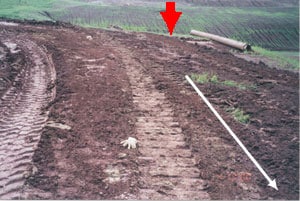
Figure 1. The red arrow represents the bulldozer’s original position when parked.
The white arrow represents the bulldozer’s path.
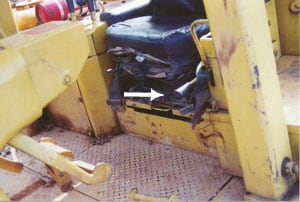
Figure 2. The arrow points to the transmission neutral safety lock.
In this position, as it was found, the bulldozer is ready for immediate movement.
Pushing the lever down towards the floor board locks the transmission into neutral.
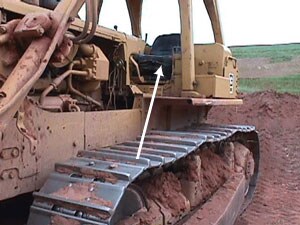
Figure 3. The arrow represents the victim’s reported path of bulldozer access.
The tip of the arrow indicates the location of the transmission selector control.
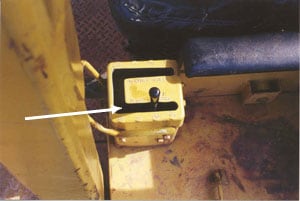
Figure 4. This photo shows the transmission selector lever in 2nd speed reverse as it was found after the incident.
The arrow represents direction of the victim’s access as well as the direction of lever movement.
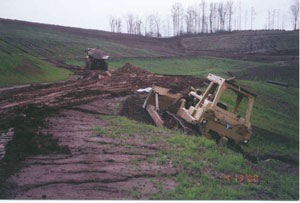
Figure 5. This was the bulldozer’s final resting place.
It was found running at full throttle in 2nd speed reverse, beginning to bury itself.
FATALITY ASSESSMENT AND CONTROL EVALUATION PROGRAM
The WVU Center for Rural Emergency Medicine, through a contract with the West Virginia Department of Health and Human Resources, conducts investigations on the causes of work-related fatalities within the state. The goal of this program is to prevent future fatal workplace injuries. West Virginia FACE intends to achieve this goal by identifying and studying the risk factors that contribute to work-place fatalities, by recommending intervention strategies, and by disseminating prevention information to employers, employees, trade associations, unions, equipment manufacturers, students, teachers, and others with an interest in workplace safety.
Please use information listed on the Contact Sheet on the NIOSH FACE website to contact In-house FACE program personnel regarding In-house FACE reports and to gain assistance when State-FACE program personnel cannot be reached.
